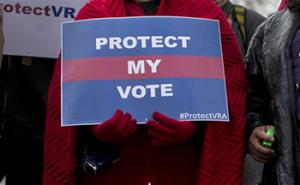
The Supreme Court will review the U.S voting district in a case which alleges that Republicans relied too heavily on race to draw new electoral maps following the 2010 census. In last week's elections, Alabama Republicans shrank their once-powerful Democratic opponents to just eight seats in the state Senate, all of them from districts in which African-Americans are a majority.
Black Democrats say the Republicans did it by misusing a landmark voting-rights law, intended to ensure the right to vote for southern blacks, to instead limit their voting strength. Republicans, they argue, relied too heavily on race to draw new electoral maps following the 2010 census.
The case goes before the Supreme Court on Wednesday. Last year a conservative majority on the court effectively blocked a key component of the Voting Rights Act, and this case will be watched closely for signs that the rest of the law could be in peril.
Like other Southern states, Alabama has undergone a decades-long change in its electorate. White voters now overwhelmingly back Republicans, leaving black voters as the Democrats' only reliable voting bloc.
Several states have accelerated that trend by invoking the voting rights law to justify concentrating black voters in certain districts so that the areas around them are proportionally more white and therefore more apt to elect Republicans. The Republicans seized control of the Alabama legislature in 2010 for the first time since Reconstruction and drew new political boundaries based on the 2010 census.

Joe Reed, chairman of the Alabama Democratic Conference, one of the state's oldest black political organizations, said the result is unconstitutional because the Republicans based their map too heavily on the racial composition of the districts.
"Look at the results last week. The proof of the pudding is in the eating," Reed said. The number of white Democrats in the 35-member state Senate dropped from four to one, though a recount is expected in another district. In the 105-member House, the number of white Democrats fell from 10 to 6.
The current court fight, similar to one in North Carolina, "is a little bit of a role reversal," said Alabama Solicitor General Andrew L. Brasher, who will defend the state's legislative districts before the Supreme Court.
"It used to be that this particular kind of claim was a claim that Republicans used to bring to prevent the creation of majority black districts. Now, you have black Democrats bringing it to try to coerce the creation of white Democratic districts," Brasher said.
Republicans said their plans complied with the voting rights law by preserving all the districts in which African-Americans were a majority and adjusting populations to comply with another principle of voting rights - that districts should contain roughly the same number of people.
Chandler reported from Montgomery, Alabama.
Copyright 2014 The Associated Press.
